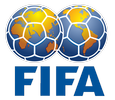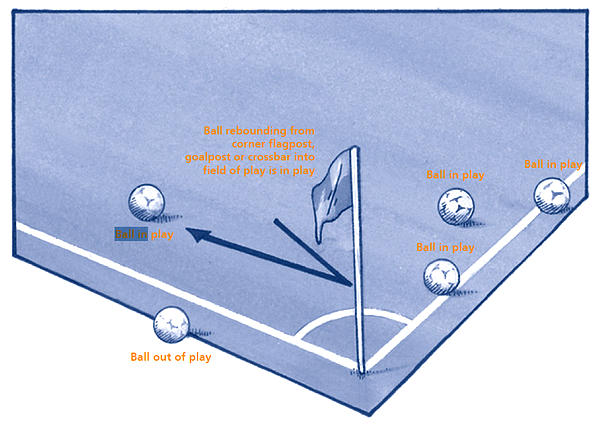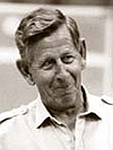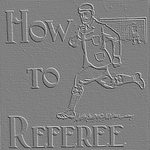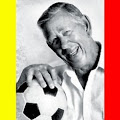 This Video from the... Ken Aston Referee Society -
This Video from the... Ken Aston Referee Society -
 Channel Channel

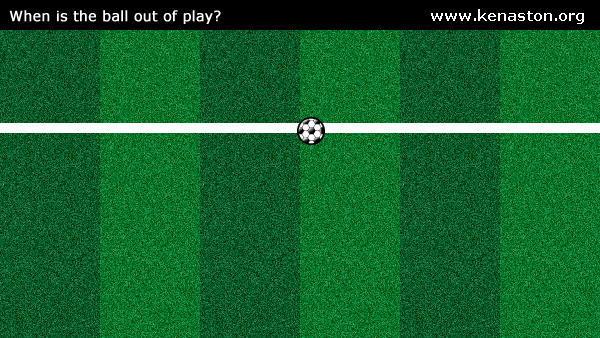 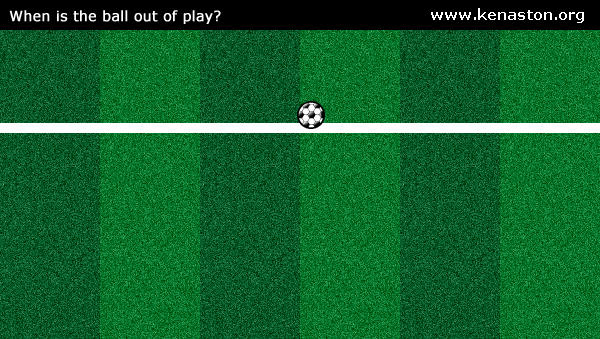 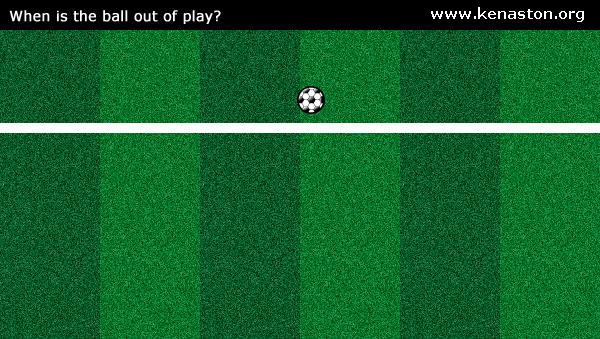 The aim of this is to recognize when the ball is out of play.
The aim of this is to recognize when the ball is out of play.
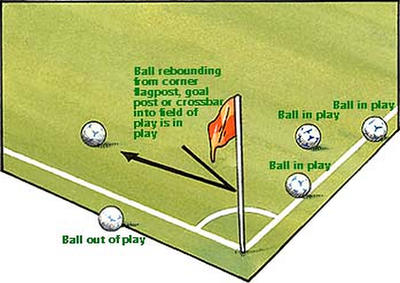 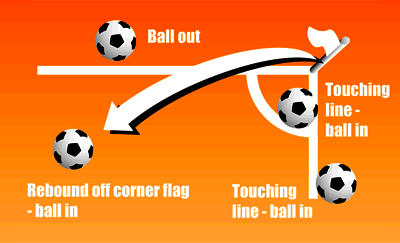 The aim of this is to recognize when the ball is out of play.
The aim of this is to recognize when the ball is out of play.
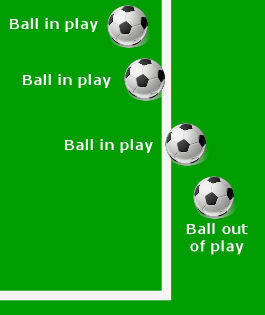 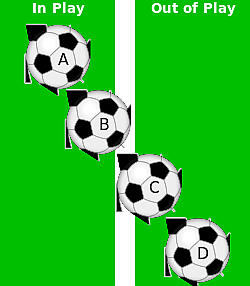 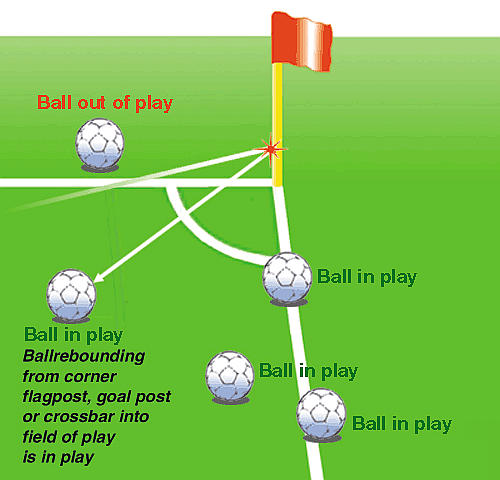
Ball Out of Play
The ball is out of play when:
 - It has wholly crossed the goal line or touch line whether on the
ground or in the air
- It has wholly crossed the goal line or touch line whether on the
ground or in the air
 - Play has been stopped by the referee
- Play has been stopped by the referee
Ball In Play
The ball is in play at all other
times, including when:
 - It rebounds from a goalpost, crossbar or corner flag post and remains
in the field of play
- It rebounds from a goalpost, crossbar or corner flag post and remains
in the field of play
 - It rebounds from either the referee or an assistant referee when they
are on the field of play
- It rebounds from either the referee or an assistant referee when they
are on the field of play
1. Ball is out of play:
The ball does not necessarily have to leave the field of play (by
traveling over the touchline or goal line) before it is deemed to be
'out of play'. The ball is also deemed out of play when the Referee
stops play whilst the ball is on the field of play.
The ball is therefore always in play, except when it has left the field
of play, or when the Referee stops play.
Law 9 is the smallest of all of the Laws - consisting of only 4 small
paragraphs.
But there is plenty more on this page to help you.
The ball is out of play:
 - When it has wholly crossed the goal line or touchline whether on the
ground or in the air. The field of play boundary lines extends upwards.
- When it has wholly crossed the goal line or touchline whether on the
ground or in the air. The field of play boundary lines extends upwards.
 - When play has been stopped by the referee
- When play has been stopped by the referee
The whole of the ball needs
to travel over the line to be out of play.
Referees will on occasions, need to make decisions from some distance
away. Players get very irate if they think that a Referee has made a
wrong decision, especially when he is standing in the center circle,
i.e. when awarding a goal kick instead of a corner. Referees' decisions
should be quick, strong and confident. Any hesitation will invite
dissent!!! The nearer the Referee is to the incident, the greater
credence he will have when making that decision. The trick is to keep
running towards the incident, whilst blowing the whistle. By the time
that the players look around, the Referee will be much closer, than
where he was when he first made his decision.
Whilst the ball is out of play, a free kick cannot be awarded for an
infringement occurring during the time that the ball remains out of
play.
The field of play is a three dimensional topless cube with invisible
vertical planes rising upwards from the outside of the each touchline
and the outside of the two goal lines. So long as the ball stays within
these invisible vertical planes or is in contact with one of these
planes, it is not deemed to be out of play. It must entirely leave this
three dimensional cube. A ball rolling along the outside of the
touchline remains in play, so long as part of the ball is hanging over
the plane of the touchline. A player may also run outside the touchline
to play the ball, so long as the ball remains in play.
The Referee (aided by the Assistant Referees) is the sole judge as to
whether a ball is in play or not.
If a foul takes place after the Referee has signaled (or decided) for
play to stop, it cannot be considered as a foul, and must be dealt with
outside of the play action itself. For example, if the Referee stops
play for an offside, and before play has restarted, a defender standing
in his own penalty area thumps an attacking player, the restart is still
the indirect free kick to the defending team, given for the offside, and
not a penalty to the attacking team (for the thumping offence).
Play is considered to have been stopped when a Referee's decision was
made, and not necessarily when the Referee's decision is announced -
there will always be a small delay between the Referee deciding to stop
play and the Referee blowing his whistle. The Referee is the sole judge
of when he has decided to stop play. Therefore no foul can be considered
a foul if it occurs after the Referee has decided (in his mind) to stop
play. A foul cannot occur after the ball has left the field of play.
Summary:
The ball is in play:
 - When it is kicked and moves forward during a kick-off (Referee must
actively start play)
- When it is kicked and moves forward during a kick-off (Referee must
actively start play)
 - When during play, it remains inside the boundaries of the field of
play
- When during play, it remains inside the boundaries of the field of
play
 - During additional time (taken to allow a penalty kick to occur at the
end of a half)
- During additional time (taken to allow a penalty kick to occur at the
end of a half)
 - During any allowance of time added onto the half by the Referee
- During any allowance of time added onto the half by the Referee
 - When it leaves the penalty area following a goal kick
- When it leaves the penalty area following a goal kick
 - When it leaves the penalty area when a player is taking the free kick
inside his own penalty area
- When it leaves the penalty area when a player is taking the free kick
inside his own penalty area
 - When it hits the ground and is touched by a player during a dropped
ball
- When it hits the ground and is touched by a player during a dropped
ball
 - When the ball is touched and moves during a free kick
- When the ball is touched and moves during a free kick
 - When the ball is touched and moves during a corner kick
- When the ball is touched and moves during a corner kick
 - When the ball is thrown into the field of play from a throw in
- When the ball is thrown into the field of play from a throw in
 - When the Referee signals commencement during a ceremonial free kick,
and the ball is kicked and moves forwards (Referee must actively start
play)
- When the Referee signals commencement during a ceremonial free kick,
and the ball is kicked and moves forwards (Referee must actively start
play)
 - When the ball is kicked and moves during the taking of a ‘quick free
kick’
- When the ball is kicked and moves during the taking of a ‘quick free
kick’
 - Before the Referee calls play back after awarding an advantage
(Referee must actively stop play)
- Before the Referee calls play back after awarding an advantage
(Referee must actively stop play)
 - When the ball rebounds back into the field of play from the goal posts
off cross bar, corner flag, Referee or Assistant Referee
- When the ball rebounds back into the field of play from the goal posts
off cross bar, corner flag, Referee or Assistant Referee
2. Ball in play:
The ball is in play at all other
times, including when:
 - It rebounds from a goalpost, crossbar or corner flag posts and remains in the field of play. - It rebounds from a goalpost, crossbar or corner flag posts and remains in the field of play.
 - It rebounds from either the Referee or an Assistant Referee when they are on the field of play . - It rebounds from either the Referee or an Assistant Referee when they are on the field of play .
NOTE- The boundary lines are part of the field of play. So a foul by a
defender on top of a penalty area line is a penalty, as the foul is
deemed to have happened inside the penalty area.
All the lines are part of the field of play, i.e. the penalty area
includes the width of its boundary lines. The field of play is marked
with lines. These lines belong to the areas of which they are
boundaries. So if a defender commits a direct free kick offence
immediately on top of his penalty area line, then a penalty is awarded
to the attacking team. All the lines on the field of play, form part of
the area boundary that they encompass. The ball only leaves any area of
the field of play, when it has passed wholly over one of the boundary
lines that encompass that particular area. Therefore that ball remains
in play when if it is positioned over the touchline or goal line.
Summary:
The ball is out of play:
 -
Before the game has started
-
Before the game has started
 -
When it wholly crosses over the boundaries of the field of play
-
When it wholly crosses over the boundaries of the field of play
 -
Whenever the Referee stops play for any reason (Referee must actively
stop play)
-
Whenever the Referee stops play for any reason (Referee must actively
stop play)
 -
When it bursts (Referee must actively stop play)
-
When it bursts (Referee must actively stop play)
 -
Whilst a substitution is taking place (Referee must actively delay the
restart of play)
-
Whilst a substitution is taking place (Referee must actively delay the
restart of play)
 -
At the end of full time in each half (Referee must actively stop play)
-
At the end of full time in each half (Referee must actively stop play)
 -
During the half time interval
-
During the half time interval
 -
During the period between full time and extra time
-
During the period between full time and extra time
 -
During the period between full time and the start of ‘The Golden Goal’
-
During the period between full time and the start of ‘The Golden Goal’
 -
At the end of additional time, taken to allow a penalty kick to occur at
the end of a half (Referee must actively stop play)
-
At the end of additional time, taken to allow a penalty kick to occur at
the end of a half (Referee must actively stop play)
 -
When the ball rebounds back into the field of play during kicks taken
from the penalty mark (Referee must actively stop play)
-
When the ball rebounds back into the field of play during kicks taken
from the penalty mark (Referee must actively stop play)
 -
At the end of any allowance of time added onto the half by the Referee
(Referee must actively stop play)
-
At the end of any allowance of time added onto the half by the Referee
(Referee must actively stop play)
 -
When a game is abandoned (Referee must actively stop play)
-
When a game is abandoned (Referee must actively stop play)
 -
Immediately after a goal has been scored
-
Immediately after a goal has been scored
 -
Until it leaves the penalty area following a goal kick
-
Until it leaves the penalty area following a goal kick
 -
Until it leaves the penalty area when a player is taking the free kick
inside his own penalty area
-
Until it leaves the penalty area when a player is taking the free kick
inside his own penalty area
 -
Before a dropped ball hits the ground and is touched by a player
-
Before a dropped ball hits the ground and is touched by a player
 -
Before the ball is touched and moves during a free kick
-
Before the ball is touched and moves during a free kick
 -
Before the ball is touched and moves during a corner kick
-
Before the ball is touched and moves during a corner kick
 -
Before the ball is thrown into the field of play from a throw in
-
Before the ball is thrown into the field of play from a throw in
 -
Until the Referee signals commencement during a ceremonial free kick
(Referee must actively start play)
-
Until the Referee signals commencement during a ceremonial free kick
(Referee must actively start play)
 -
When the Referee calls play back after awarding an advantage (Referee
must actively stop play)
-
When the Referee calls play back after awarding an advantage (Referee
must actively stop play)
 -
If it is interfered with by any outside interference (Referee must
actively stop play)
-
If it is interfered with by any outside interference (Referee must
actively stop play)
3. Diagram Ball In/Out of Play ?
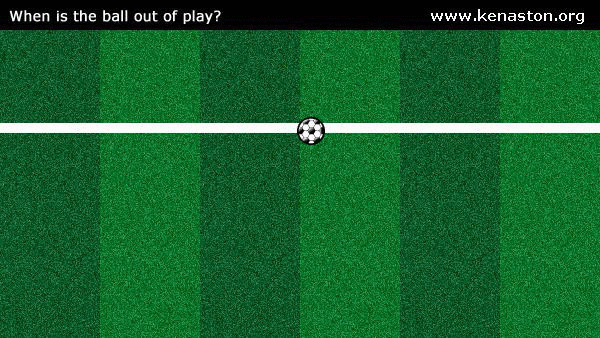
+-+ BACK TO TOP +-+
+-+ FIFA-ADDITIONAL +-+
+-+ ADVICE from 'THE PITCH' +-+
Questions and Answers:
This web site and the advice and answers to any questions are not
sanctioned by or affiliated with any governing body of soccer. The
opinions expressed on this site should not be considered official
interpretations of the Laws of the Game. Although the content of the
latest Laws are included on this site, the majority of the content is
the opinion of the Webmaster and other Referees worldwide. If you need
an official ruling you should contact your local
representative/association or visit the FIFA, or the English FA web
sites for the Laws themselves.
Questions and Answers:
Question 1: Is it possible for a player to step outside the field of
play, and still legally play the ball when it remains on the touchline
or on the goal line or just inside the field of play?
Answer 1: Very often during a match, a player's momentum takes him
outside of the field of play boundaries. This action is not done in an
unsporting way, but is a continuation of the player’s momentum. This
type of movement is not illegal. Players also stand outside of the
boundaries when taking throw-ins, corners, free kicks and goal kicks.
Players taking such action should not be cautioned for leaving the field
of play without the Referee's permission. In the situation described
above in question 1, only the position of the ball is relevant. Because
the ball remains on the field, it is deemed to be still in play. A
player is entitled to step outside of the boundaries, to control the
ball, or to run to an advantageous position. It is the position of the
ball, not the player's feet that are the important factors here.
Players may leave the field of play and re-enter it as long as this
occurs during the normal course of play, and is part of the match
action.
There are a few exceptions to this that Referees should be aware of.
During a corner kick, players (particularly attacking players) are not
permitted to cross the goal line between the goal posts (i.e. stand or
walk behind the goal line under the nets themselves). This is tantamount
to unsporting behavior, and must be stopped before the corner is taken.
If an attacker steps over the goal line between the goal posts, as the
ball is in flight from a corner, the Referee should stop play. He has
two options to restart the match.
 -
(a) Caution the attacking player and restart with an indirect free kick
to the defending team (Law 12 "An indirect free kick is awarded for any
other offence not mentioned in Law 12,for which play is stopped to
caution or dismiss a player".)
-
(a) Caution the attacking player and restart with an indirect free kick
to the defending team (Law 12 "An indirect free kick is awarded for any
other offence not mentioned in Law 12,for which play is stopped to
caution or dismiss a player".)
Or
 -
(b) Award a dropped ball, at the position that the ball was, when the
Referee stopped play.
-
(b) Award a dropped ball, at the position that the ball was, when the
Referee stopped play.
You can consider just awarding an indirect free kick to the defending
team and a strong word to the perpetrator (instead of a caution) but
this is not the correct method by the 'letter of the Law'. Albeit, that
I have used the latter method on numerous occasions (under the auspices
of Law 18 Common sense). Players will soon get the message after you
have penalized them for taking such action - they will not do it again!
So at least you will have educated the player.
Note: Players, managers, coaches and spectators should be at least a
yard (1m) or more from the field of play boundaries, to allow room for
players to play the ball near the touchline and to allow the Assistant
Referees to judge whether the ball is in or out of play.
In order to be considered out of play, the entire ball must cross the
line (either on the ground or in the air). If any part of the ball
remains on the line, then it is still in play. As a result, you will
often see players run out over the boundaries to tap a ball off of the
line and back into play. In most cases, the Assistant Referee will
decide if the ball has gone out of play or not.
Question 2: Is the ball deemed out of play if any part of the ball
overlaps the touchline or the goal line?
Answer 2: No. The whole of the ball must cross the line before it is out
of play.
Question 3: If the ball bounces directly over the touchline without
having been touched by a player during a dropped ball, what action
should the Referee take?
Answer 3: During a dropped ball, the ball is only deemed to be in play
when it has touched the ground and has been touched by a player. In this
case, only one of the stipulations has occurred. The Referee should
restart play by dropping the ball again, in the same position as before.
Question 4: What action should the Referee take if one of the teams
refuses to take part in a dropped ball?
Answer 4: It is not necessary for a member of each team to be present at
a dropped ball. The Referee should merely restart by dropping the ball
to the participating team player.
Question 5: Is it possible for the ball to be still in play if it curves
out of play over the touchline in the air, and then curves back in
before hitting the ground inside the field of play?
Answer 5: No. All the boundary lines extend upwards in a vertical plane.
If the ball crosses this vertical plane, it becomes out of play. The
fact that the curve of the ball, enables it to leave and then re-enter
the field of play, does not negate the fact that it has wholly crossed
over the touchline (and is therefore out of play.) This type of problem
sometimes occurs during the taking of a corner kick, when the ball
curves out over the goal line, and bends back into the field of -play.
The Referee and his Assistants need to be vigilant to such possibilities
happening.
Question 6: As the ball travels towards a defender in his own penalty
area, a spectator blows a whistle. The defender assumes that play has
been stopped by the Referee, and picks up the ball. What action should
the Referee take?
Answer 6: There is nothing in the Laws to compensate for mistakes made
by players. The Referee should award a penalty kick. The same result
would be true if the player reacted to a Referee's whistle from an
adjacent field.
Of course, the Referee should exercise Law 18 Common sense when dealing
with these types of situations. Awarding a penalty is 'all well and
Dandy' if you are Refereeing a top class match where there are thousands
of spectators (hundreds of whom will be blowing whistles of all sorts
throughout the game) but on the local park, the award of a penalty will
jeopardize your chances of reaching the changing room in one piece! You
could consider restarting with a dropped ball (for external
interference) to the defending team only. Although this is wrong in Law,
it is correct in the 'spirit of the game' albeit that FIFA stipulates
that a penalty should be awarded. If you do award a penalty, be prepared
for some verbal hostility!!!! during and after the game.
Question 7: When a ball is touching the line or when its edge is still vertically over
the line but not touching the line (even though the rest of it is
hanging outside of the line); is the ball out of play or is it still in
play.
Answer 7: To be out of play, the ball has to cross WHOLLY over the
touchline or the goal line (either in the air or on the ground). In both
the cases above, the ball is still in play
Question 8: During play, a
player asks (the Referee) to leave the field of play to receive
treatment for an injury. Whilst he is in the process of walking off the
field of play, the ball comes near him. He controls the ball and then
shoots and scores a goal. Should this goal count, and what action should
the Referee take?
Answer 8: Play does not need to be stopped for a player to leave the
field to receive treatment for an injury. As the player had asked, and
obtained permission from the Referee to leave the field of play - from
that moment, he is not allowed to take any part in play until he has
left the field of play, and has subsequently received a signal from the
Referee to return. The goal should not count. The player should be
cautioned for unsporting behavior, and the game restarted with an
indirect free kick to the opposing side, from the place that the player
was when he touched the ball before scoring the goal.
Question 9: During a play,
the ball was seen to wholly cross the touchline, but the Referee did not
blow for a throw-in, and allowed play to continue - even after protests
from one of the teams. I thought that a throw-in was awarded when the
ball wholly crosses over the touchline?
Answer 9: It is impossible for a Referee to always be 100 per cent
certain if a ball has wholly crossed the touchline or not. There are
many occasions during a match that the Referee is many yards away from
the touchline, but is still required to make decisions on throw-ins.
It may be that this Referee was too far from play to be certain that the
ball had crossed the line or not. Many of the decisions made by a
Referee are based on judgment - sometimes he gets it right, and
sometimes he gets it wrong. The final decision is always in the hands of
the Referee, and he alone (with the help from any Assistant Referees) is
responsible for starting and stopping play. If players are in doubt,
they should continue playing and listen for the Referee's whistle. How
many times have you heard players shouting to their colleagues "play to
the whistle"?
Question 10: A team is
awarded a throw-in. A player runs off the field of play, collects the
ball, and is just about to take the throw-in, when a colleague signals
that he will take the throw instead, and shouts, " I'll take it". The
player holding the ball lobs the ball underhand to his colleague who is
still on the field of play, and is making his way towards the touchline.
Isn't this a foul throw, and shouldn't the throw-in be awarded to the
opposition?
Answer 10: The original player is obviously not trying to cheat - this
is an action that happens many times during a game. It is recognized by
both Referees’ and players’, that this action is not in itself an
infringement of the Laws.
Most Referees (and I would like to think that this is ALL Referees)
recognizes that the first player was not attempting a throw-in, but just
passing the ball to his colleague to take the throw instead.
I suppose that it is possible that a Referee may consider the first
action an attempted throw-in - but let's be honest, the Referee who does
this is asking for trouble!
Question 11: When a foul
occurs, is the ball out of play as soon as the foul occurs?
Answer 11: No. A Referee will very often allow advantage to keep the
play flowing. The ball is only out of play when it wholly crosses the
goal line or the touchline, or when the Referee stops play. The only
time that a ball is out of play during a foul, is when the Referee has
signaled for play to stop - usually by blowing his whistle very hard.
Question 12: When a player
takes a throw-in down the touchline and it eventually lands out of play
without touching another player, (a) sometimes the Referee will ask for
the throw-in to be retaken, and (b) sometimes he will award a throw-in
to the opposing team - why is this?
Answer 12:
 -
(a) If the ball does
not enter the field of play, then the throw-in must be retaken. The ball
never crossed over the outside edge of the touchline but instead,
traveled totally outside of the field of play.
-
(a) If the ball does
not enter the field of play, then the throw-in must be retaken. The ball
never crossed over the outside edge of the touchline but instead,
traveled totally outside of the field of play.
 -
(b) During a throw-in, the ball is deemed to be in play as soon as it
enters the field of play (assuming that the thrower executed the
throw-in correctly). If, (in the opinion of the Referee or the Assistant
Referee) the ball initially enters the field of play (for example, at
least some part of the ball crossed over the outside edge of the touch
line), and then the ball curves back out of play wholly over the
touchline, a throw-in should be awarded to the opposing team.
-
(b) During a throw-in, the ball is deemed to be in play as soon as it
enters the field of play (assuming that the thrower executed the
throw-in correctly). If, (in the opinion of the Referee or the Assistant
Referee) the ball initially enters the field of play (for example, at
least some part of the ball crossed over the outside edge of the touch
line), and then the ball curves back out of play wholly over the
touchline, a throw-in should be awarded to the opposing team.
Question 13: When I was
watching a match the other day, some restarts did not happen until the
Referee had blown his whistle or signaled with his arm (or voice) for
play to recommence, and at other times, players just carried on without
any intervention by the Referee. Surely this is very confusing for the
players?
Answer 13: No, not really.
Players know that if the Referee wants to control restarts, then he will
let players' know (either by using his whistle or by talking to them).
For example, during the 'ceremonial' type free kicks near the goals, the
Referee will orchestrate the taking of the free kick. This allows the
defensive wall to position itself, and for the attacking team to discuss
shooting tactics. This is now an accepted part of football. If a team
takes a 'ceremonial' type free kick before the Referee has signaled,
then the kick should be retaken. The Referee usually tells the players
not to start (ceremonial free kicks) until they have received his
signal, and he does this by tapping his whistle or pointing to it,
indicating that players must wait for a whistle before executing the
free kick.
The Referee is not advised to blow his whistle every time the ball goes
out of play - if he does, he will annoy, not only the players, but
everyone watching the game as well! As a default, players will
automatically continue restarts if the Referee does not intervene. This
allows the game to flow without undue stoppage or interference by the
Referee.
Players are taught by coaches to quickly restart the game when it is to
their team's advantage, and an alert player who quickly puts the ball
back into play with the appropriate throw-in or free kick may gain a
scoring opportunity.
There are occasions when the Referee will need to signal with his
whistle, for restarts of play, and some advice examples are shown below:
 -
(a) If time allows, always try to blow your whistle to signal before a
corner kick takes place. Corner kicks usually entail players of both
sides needing to position themselves accordingly in a crowded goal area,
and it is a nice touch by the Referee to use his whistle to signal this
restart. There will be occasions when the Referee is not able to signal
for a corner start (for example, when a quick corner is taken - the
Referee should allow play to continue in this instance, without having
recourse to his whistle.
-
(a) If time allows, always try to blow your whistle to signal before a
corner kick takes place. Corner kicks usually entail players of both
sides needing to position themselves accordingly in a crowded goal area,
and it is a nice touch by the Referee to use his whistle to signal this
restart. There will be occasions when the Referee is not able to signal
for a corner start (for example, when a quick corner is taken - the
Referee should allow play to continue in this instance, without having
recourse to his whistle.
 -
(b) If the ball has traveled some distance away from the touchline (or
goal line), and takes a few moments to be retrieved, or if a replacement
ball has been called for - the Referee should use his whistle to
indicate that the throw-in (or goal kick) may be taken. This allows
players who have 'switched-off' to regain their concentration before
play is restarted.
-
(b) If the ball has traveled some distance away from the touchline (or
goal line), and takes a few moments to be retrieved, or if a replacement
ball has been called for - the Referee should use his whistle to
indicate that the throw-in (or goal kick) may be taken. This allows
players who have 'switched-off' to regain their concentration before
play is restarted.
 -
(c) The Referee should always blow his whistle to restart a match after
a player has received treatment on the field of play.
-
(c) The Referee should always blow his whistle to restart a match after
a player has received treatment on the field of play.
 -
(d) Referees are advised to blow their whistle during kick-offs from the
center spot.
-
(d) Referees are advised to blow their whistle during kick-offs from the
center spot.
 -
(e) It is not essential to blow for dropped ball restarts - but the
Referee may need to blow his whistle to attract attention of two willing
participants.
-
(e) It is not essential to blow for dropped ball restarts - but the
Referee may need to blow his whistle to attract attention of two willing
participants.
 -
(f) Always blow for the commencement of penalties or ceremonial type
free kicks near the goal areas.
-
(f) Always blow for the commencement of penalties or ceremonial type
free kicks near the goal areas.
 -
(g) If a team has a long-ball thrower, the Referee can blow for
throw-ins by this player - this is because such a thrower can easily
project the ball into the penalty area near the goal itself. It is a
nice touch by the Referee to indicate the restart during these occasions
- and invariably, the thrower will need to take a long run-up whilst
making his throw, and will very often look to the Referee for a signal
to commencement.
-
(g) If a team has a long-ball thrower, the Referee can blow for
throw-ins by this player - this is because such a thrower can easily
project the ball into the penalty area near the goal itself. It is a
nice touch by the Referee to indicate the restart during these occasions
- and invariably, the thrower will need to take a long run-up whilst
making his throw, and will very often look to the Referee for a signal
to commencement.
 -
(h) Always signal with the whistle to restart play after a substitution
has been made.
-
(h) Always signal with the whistle to restart play after a substitution
has been made.
These are just a few
examples where the Referee needs to signal clear restarts.
Question 14: Immediately
following a kick-off after a goal had been scored, and before the ball
had left the center circle, the Referee spots one of his Assistant
Referees indicating an off-side flag occurrence before the goal had been
scored. What action should the Referee take?
Answer 14: Law 5 states that:
"The Referee may only change a decision on realizing that it is
incorrect or, at his discretion, on the advice of an Assistant Referee,
provided that he has not restarted play".
In this case, the Referee must allow play to continue, since he cannot
change the decision to award a goal after play has restarted.
If the goal was awarded to the away team, I suppose the Referee will not
get any free drinks at the clubhouse at the end of the match!!!! His
Assistant might be lucky though?
Question 15: If the ball hits
the frame of the goal and rebounds back onto the field of play - is the
ball still in play?
Answer 15: Yes: For the ball to
be out of play, it must wholly cross the goal line. In this case, the
goal frame is inside of the field of play and the ball did not leave the
field of play. Occasionally a ball will even roll along the crossbar of
the goal frame and then fall back onto the field of play.
In a similar situation, if the ball rebounds off an Assistant Referee
who is standing inside the field of play - play continues because the
ball did not leave the field of play. The Referee and Assistant Referees
(when they are on the field of play), the goal frame and the corner
flags are all part of the field of play. The Referee is just like a
stone on the field of play, and is merely part of the field of play. If
the ball hits the Referee, play should continue just as if the ball
bounced off the stone - and this includes when the ball bounces into the
goal, it is a goal! (This is the main reason why Referees always stay
outside of the goal area.)
But why was the stone on the field of play in the first place, surely
the Referee should have spotted the stone in his pre-match field
inspection!!!
Question 16: If a match is
being played on a field of play that doubles as an English Rugby
football field, where the frames of the football goal posts extend and
continue upwards from the crossbar for the Rugby posts, and the ball
strikes the upper part of the post above the level of the crossbar, what
action should the Referee take.
Answer 16: A football goal
frame should not have goal posts extending above the level of the
crossbar. The construction of football goal posts is covered in Law 1.
Rugby type goal frames are not officially allowed to double up as
football goal frames. The Referee should not have sanctioned playing on
such a field of play.
If the ball strikes the higher goal post (that part of the post, which
extends higher than the level of the crossbar) - and the ball rebounds
back into play - what does the Referee do? Allow play to continue, or
award a dropped ball? Or award a goal kick, or a corner? Phew...........
Just don't play it in the first place.
Except??????....... as kindly pointed out by Craig Allomes from
Australia.....
" This is a very common occurrence in Australia, where soccer is not the
dominant sport - particularly in schoolboy games on school ovals which
have to double (or triple) up on sports. The accepted treatment is -
ball is out of play, restart with a goal or corner kick as appropriate.
Even more confusing is where a soccer field is located on a rugby and/or
Aussie Rules field - there are a multitude of lines marked on the grass
- usually all the same color. Leads to a lot of confusion and drop
balls!!"
Many thanks to Craig for that interesting point.
I suppose we must not lose track of our origins. As a lad, all we needed
to make a field of play was a couple of jumpers (sweaters) for
goalposts. We did not worry about lines. Of course, the official answer
will always be, that the field of play (including the structure of the
goalposts) must conform to the Law 1 Field of Play regulations - but in
real life, if you had the choice of playing a game on an unconventional
field of play, or not playing at all - I know which I would choose!
Question 17: (answers in
brackets). Should the match be stopped and what is the restart when a
ball that is just about to leave the field of play over the touchline
is:
 -
(a) Picked up and handled by a player on the field of play. (Direct free
kick to opposing team, possible caution for the player who picked the
ball up).
-
(a) Picked up and handled by a player on the field of play. (Direct free
kick to opposing team, possible caution for the player who picked the
ball up).
 -
(b) Picked up by one of the substitutes who is watching the game, but
decides to come onto the field of play and pick the ball up. (This is
outside interference. Dropped ball restart and possible caution for the
substitute).
-
(b) Picked up by one of the substitutes who is watching the game, but
decides to come onto the field of play and pick the ball up. (This is
outside interference. Dropped ball restart and possible caution for the
substitute).
 -
(c) Picked up by the manager/coach of one of the teams. (This is outside
interference. Dropped ball restart and a strong 'telling-off' for the
manager/coach). If it happens again, report the manager/coach, and ask
them to leave the vicinity of the field boundary.
-
(c) Picked up by the manager/coach of one of the teams. (This is outside
interference. Dropped ball restart and a strong 'telling-off' for the
manager/coach). If it happens again, report the manager/coach, and ask
them to leave the vicinity of the field boundary.
 -
(d) Hits the cold water bucket that just happens to be on the touchline
itself, and rebounds back into play. (This is outside interference.
Dropped ball restart and a 'telling-off' to whomever left the bucket on
the touchline.
-
(d) Hits the cold water bucket that just happens to be on the touchline
itself, and rebounds back into play. (This is outside interference.
Dropped ball restart and a 'telling-off' to whomever left the bucket on
the touchline.
 -
(e) Rebounds back into the field of play off of the Assistant Referee's
leg. (Nothing. Play continues, since the ball did not leave the field of
play - but the Referee should advise his Assistant (after the game or at
half time or discretely during the remainder of the match) to keep out
of the field of play when the ball is near him.
-
(e) Rebounds back into the field of play off of the Assistant Referee's
leg. (Nothing. Play continues, since the ball did not leave the field of
play - but the Referee should advise his Assistant (after the game or at
half time or discretely during the remainder of the match) to keep out
of the field of play when the ball is near him.
 -
(f) Burst or becomes deflated. (Dropped ball restart).
-
(f) Burst or becomes deflated. (Dropped ball restart).
 -
(g) Picked up by the 3-year-old daughter of one of the player's. (This
is outside interference. Dropped ball restart).
-
(g) Picked up by the 3-year-old daughter of one of the player's. (This
is outside interference. Dropped ball restart).
In all of the above situations, the Referee must take steps to make sure
that it does not happen again.
Question 18: During the
taking of a corner kick, the ball strikes the near goal post and
rebounds back into the field of play, but the Assistant Referee is seen
to raise his flag to indicate that the ball was out of play. The Referee
blew his whistle to stop play. I thought that the goal post was part of
the field of play; why was play not allowed to continue?
Answer 18: The ball had
probably curved wholly over the goal line and then curved back into play
before it hit the goal post. Play was stopped because it completely left
the field of play after it was kicked and before it struck the goal
post. The Assistant Referee was correct, and the restart is a goal kick.
Question 19: The ball
rebounds back into play from the halfway line flag post. What action
should the Referee take?
Answer 19: Award a throw-in to
the appropriate team. The flag posts should be situated not less than 1
meter (1 yard) outside the touchline - therefore the ball must have
traveled outside of the field of play.
If the flag posts had been placed incorrectly, and were positioned on
the touchline itself, then a dropped ball should be awarded for outside
interference. The Referee should ensure that the flag posts are
positioned correctly, before allowing play to continue.
|
